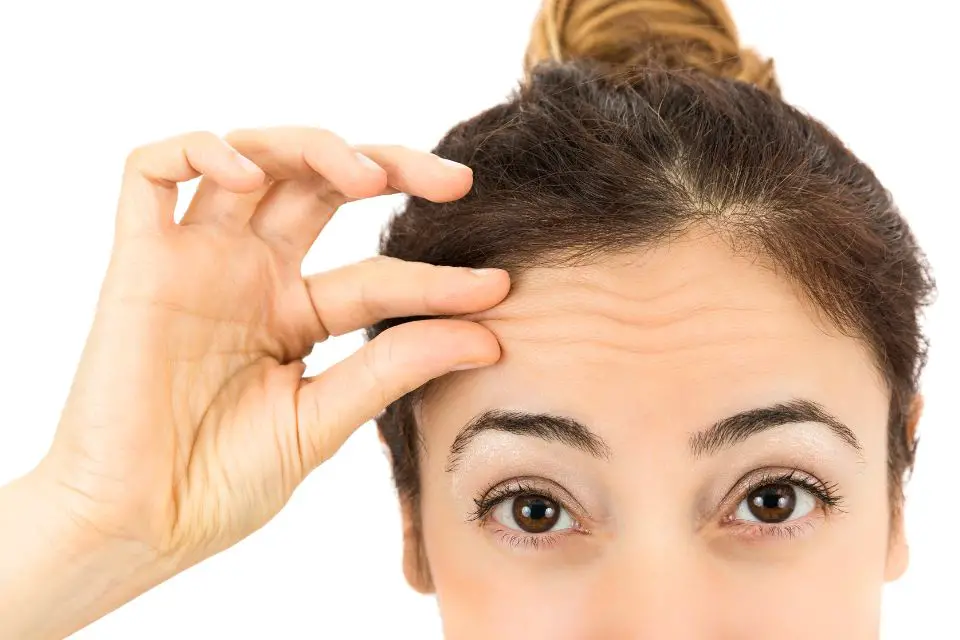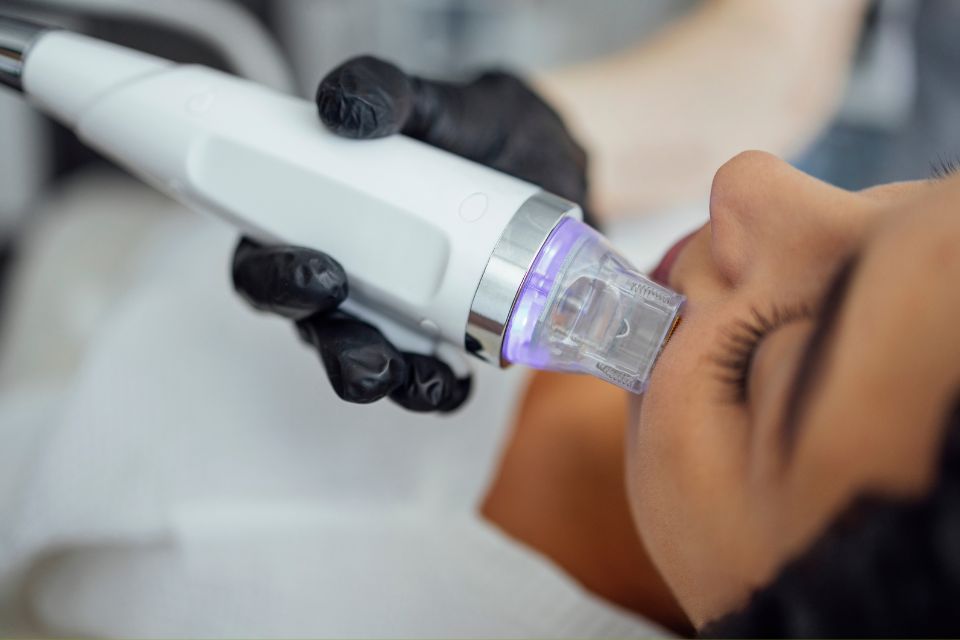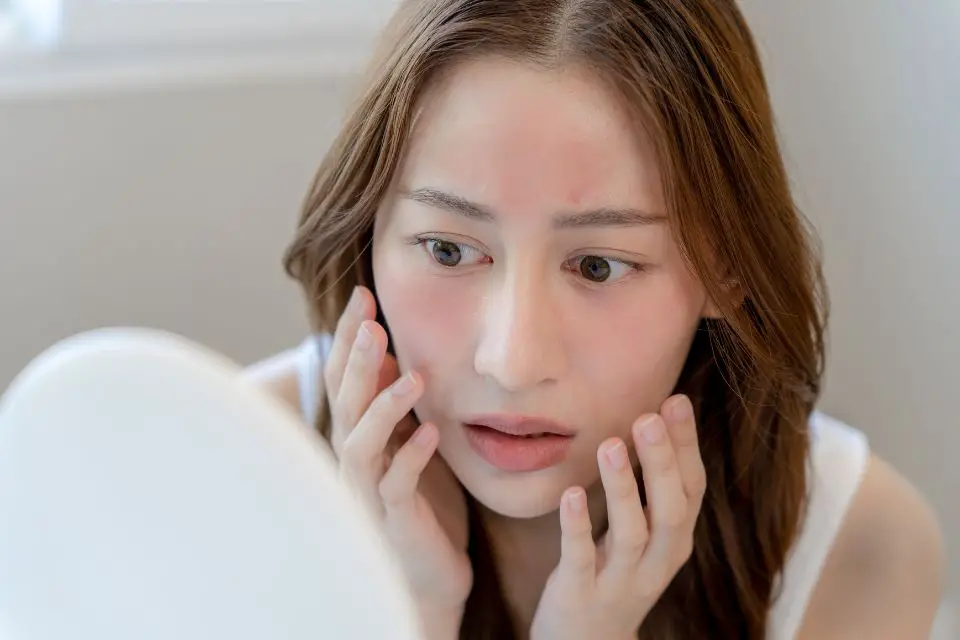Stretch marks can be extremely frustrating to deal with. In addition to appearing on various body parts, they are also challenging, if not impossible, to get rid of! But before you give up trying to get rid of those so unpleasant scars, you might want to look into microneedling, a recent and useful procedure.
But wait, can stretch marks be treated with microneedling? Is the process efficient and safe?We’ll address each of these significant queries in-depth in this post! We will go over the definition of microneedling and how it works to remove stretch marks.
This article will assist you in determining whether microneedling for stretch marks is a worthwhile treatment option for you. To learn more, continue reading!

What Are Stretch Marks?
Stretch marks, medically known as striae, are long, narrow streaks, stripes, or lines that develop on the skin. They often have a different texture and color than the surrounding skin. These marks can appear on various parts of the body, most commonly on the abdomen, thighs, hips, buttocks, breasts, and upper arms.
The primary cause of stretch marks is the stretching of the skin beyond its normal limits. This can occur during periods of rapid growth, such as puberty or pregnancy, as well as during significant weight fluctuations. The stretching disrupts the normal production of collagen and elastin, which are essential proteins that maintain the skin’s elasticity. As a result, the skin may not be able to keep up with the rapid changes, leading to the formation of stretch marks.
Initially, stretch marks may appear red, pink, purple, or dark brown, depending on your skin tone. Over time, they often fade to a lighter color and may become less noticeable, but they typically do not disappear completely. While stretch marks are a natural and common occurrence, they can be a source of cosmetic concern for some individuals.
Various treatments, such as topical creams, laser therapy, and microdermabrasion, are available to help reduce the appearance of stretch marks, although complete removal is challenging. It’s essential to note that these treatments may vary in effectiveness, and consulting with a healthcare professional or dermatologist is advisable for personalized advice and guidance.
How Do You Treat Stretch Marks?
Treatment options for stretch marks aim to improve their appearance rather than complete removal. Topical treatments like retinoid creams and hydrating lotions can be used, although retinoids are not recommended during pregnancy. Laser therapy, microdermabrasion, chemical peels, and microneedling are procedures that promote collagen production and skin regeneration, potentially reducing the visibility of stretch marks. Prescription medications like tretinoin may be considered under medical supervision. In more extreme cases, surgical procedures such as abdominoplasty (tummy tuck) can be explored, particularly for abdominal stretch marks post-pregnancy. Consulting with a dermatologist or healthcare professional is crucial to determine the most suitable treatment based on individual circumstances.
It is advised that you see a dermatologist, particularly if you are expecting or breastfeeding your baby, since they can provide you with advice on the best therapies for you.
It’s always best to be cautious because some lotions or treatments may have adverse effects that could harm the unborn child.
Most expectant mothers typically wait to receive stretch mark therapy until after their babies are born.
What Is Microneedling?
When topical lotions or prescription treatments are ineffective, many patients with stretch marks turn to microneedling In order to get the desired outcomes.
Microneedling is a cosmetic procedure that involves using a device with fine, short needles to create tiny, controlled punctures (micro-injuries) in the skin’s surface. The procedure is also known as collagen induction therapy. These micro-injuries stimulate the body’s natural wound healing processes, leading to increased collagen and elastin production. Collagen and elastin are proteins that contribute to the skin’s strength, elasticity, and overall texture. As the skin heals from these micro-injuries, it may appear firmer, smoother, and more rejuvenated. Microneedling is often used to address various skin concerns, including fine lines, wrinkles, scars, and stretch marks. The procedure is typically performed by a dermatologist or licensed skincare professional and may involve the application of a numbing cream to minimize discomfort. While microneedling can be done with various devices, including rollers and automated pens, the goal remains the same: to stimulate the skin’s natural regeneration process for overall skin improvement.
Your skin then goes through the biological phases of healing, which include the phases of inflammation, proliferation, and remodelling.
1:Inflammatory phase
This is where the rapid release of proteins or growth factors to promote skin tissue healing, inflammation, and cell proliferation occurs. Immune cells additionally remove any tissue damage or debris from the microneedling procedure here. After therapy, this stage may extend for up to seven days.
2:Proliferation phase
This is the area where elastin and type 3 collagen are formed and produced by the skin. Additionally, new blood vessel formation takes place, increasing oxygen, nutrients, and blood flow to the treated area. After therapy, this phase usually lasts three to fourteen days.
3: Remodeling phase
This is when the skin that has been treated tightens and firms, resulting in skin that is smoother and more toned. After therapy, this phase may extend for two weeks to six months.
Microneedling is useful in treating a range of skin issues that arise from compromised skin health since it is intended to increase the production of collagen and stimulate the creation of new cells. Additionally, it works well for a variety of skin tones and skin types.
What Skin Problems Does Microneedling Address?
Microneedling is a versatile cosmetic procedure that can address several skin concerns. Here’s a list of skin problems that microneedling may help improve:
Fine Lines and Wrinkles:

Microneedling stimulates collagen production, which can help reduce the appearance of fine lines and wrinkles, promoting smoother skin.
Scars:
Microneedling can be effective in improving the texture and appearance of scars, including acne scars and surgical scars, by promoting collagen remodeling.
Stretch Marks:
The procedure may help minimize the visibility of stretch marks by stimulating collagen synthesis and promoting skin regeneration.
Enlarged Pores:
Microneedling can contribute to the reduction of enlarged pores by promoting collagen production, which helps improve skin elasticity.
Uneven Skin Tone and Texture:
By encouraging the growth of new, healthier skin cells, microneedling can help achieve a more even skin tone and smoother texture.
Sun Damage and Pigmentation Issues:
Microneedling may assist in addressing sun damage and hyperpigmentation concerns by promoting skin renewal and melanin distribution.
Age Spots and Hyperpigmentation:
The procedure can contribute to a more even distribution of pigmentation, helping to reduce the appearance of age spots and other forms of hyperpigmentation.
General Skin Rejuvenation:
Microneedling can promote overall skin rejuvenation, leading to a fresher and more youthful appearance.
The face is the most common place for microneedling because to the prevalence of blemishes and skin issues there.
However, areas of the body like the legs, neck, belly, thighs, and back that are afflicted by certain skin conditions can also undergo microneedling.
In the end, microneedling will undoubtedly improve your appearance!
It’s essential to note that the effectiveness of microneedling can vary from person to person, and multiple sessions may be required to achieve the desired results. Consulting with a dermatologist or licensed skincare professional is crucial to determine the suitability of microneedling for specific skin concerns and to receive personalized advice on the number of sessions and aftercare.
Does Microneedling Work on Stretch Marks?

Microneedling has been found to be effective in improving the appearance of stretch marks. The procedure involves creating controlled micro-injuries in the skin using fine needles, which stimulates the body’s natural healing processes, including collagen production. Collagen is a crucial protein that provides structure and elasticity to the skin.
When microneedling is applied to stretch marks, it can help:
1:Promote Collagen Production:
Microneedling stimulates the production of collagen in the affected areas, which may lead to improved skin texture and elasticity.
2:Reduce Redness and Pigmentation:
The procedure may contribute to a reduction in the red or dark color often associated with fresh or recent stretch marks.
3:Enhance Overall Skin Appearance:
By encouraging the growth of new skin cells, microneedling can lead to a more uniform skin surface and a diminished appearance of stretch marks.
How Is Microneedling Done on Stretch Marks?
The average microneedling session lasts 10 to 20 minutes, although the exact amount of time needed will depend on the size of the affected area. If you have stretch marks on your stomach, butt, belly, or thighs, it can take longer.
Here’s how the process of microneedling typically goes:
1: To minimize pain and discomfort, your dermatologist or aesthetician will clean the region to be treated before applying numbing cream.
2: To induce “microinjuries,” the microneedling device will be moved across the treated area.
3: To stop itching and drying out, a calming lotion or serum will be administered to the treated region.
You may notice that your skin looks flushed or very red after the procedure. Rest assured, this will go away 48 hours following therapy.
Pro tip: To promote better skin healing, don’t forget to use aftercare treatments to the treated region.
How Often Should Microneedling Be Done on Stretch Marks?
The frequency of microneedling sessions for stretch marks can vary depending on individual factors and the severity of the stretch marks. It is generally recommended to space out microneedling sessions:
Initial Sessions:
Begin with an initial series of sessions spaced about 4 to 6 weeks apart. This allows for adequate healing time between treatments.
Assessment and Progress:
After a few sessions, assess the progress and consult with your dermatologist or skincare professional to determine if additional sessions are needed.
Maintenance Sessions:
For ongoing maintenance, individuals may opt for occasional sessions every few months or as recommended by their skincare provider.
Individual Response:
The number of sessions needed can vary based on individual response, the age of the stretch marks, and other factors.
Patience and Consistency:
Patience is key, as visible improvements may take time. Consistency in following the recommended treatment plan is crucial for optimal results.
Consultation with Professionals:
Always consult with a qualified dermatologist or skincare professional to tailor the treatment frequency to your specific needs and monitor your progress.
It’s important to note that microneedling should be performed by trained professionals, and individual responses to the treatment can vary. Consulting with a skincare expert will help determine the most appropriate treatment plan based on your unique circumstances and goals.
Are There Side Effects or Risks Involved in Microneedling Your Stretch Marks?
Although microneedling is a minimally invasive technique, it still requires skin punctures, so there are certain things to think about before doing it.First of all, following the treatment, you can feel pain and redness. Additionally, it could make your skin feel extremely tight or peel or flake.
You may need to minimize the amount of environmental elements that come into contact with your treated skin because it may take many days or even weeks for it to heal.

But, if the treated region continues to swell for more than a week or bleeds for more than 24 hours, you should contact your doctor. Finally, even though there’s a minimal chance of developing a skin infection after microneedling, it’s still advisable to exercise caution.
By receiving treatment at a respected facility and making sure that all treatment-related instruments are well cleaned before use, you can reduce your risk of infection as much as possible.
Related Reading: What Is Microchanneling? Everything You Need to Know


